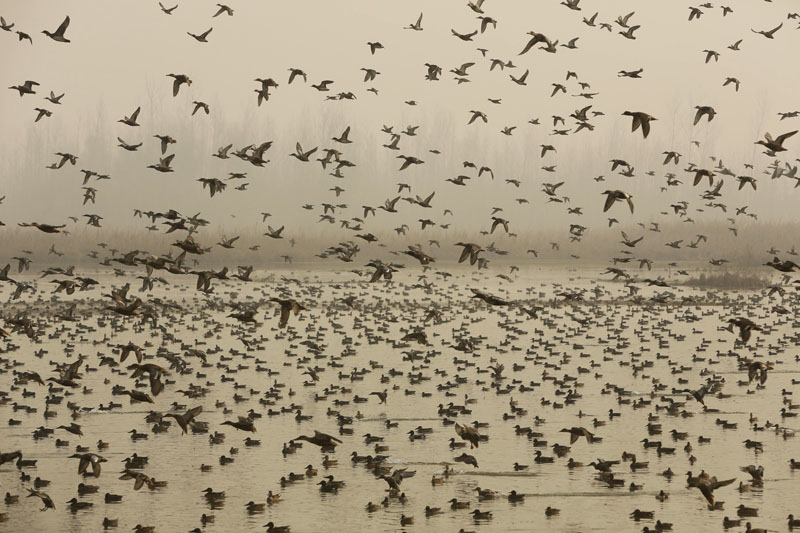Kathmandu, February 2, 2025
Nepal, a landlocked country nestled in the lap of the Himalayas, is more than a paradise for trekking and mountain climbing enthusiasts. It is also a critical transit point for migratory birds that traverse thousands of kilometers across continents. Serving as a crossroads for two significant migratory flyways, Nepal plays a pivotal role in global bird conservation. However, this journey is not without its challenges. This article explores the fascinating migration of birds through Nepal, the ecological significance of their habitats, and ongoing conservation efforts.
Photo Credit: AP
1. Migration Routes: A Crossroads for Global Avian Travelers
Nepal intersects two major migratory flyways:
The East Asian-Australasian Flyway (EAAF) connects the Arctic regions of Russia and Alaska to Southeast Asia and Australasia. Nepal's wetlands and river systems act as vital stopovers for migratory waterfowl, waders, and shorebirds traveling along this route.
The Central Asian Flyway (CAF) spans from Central Asia's breeding grounds, including Russia and Kazakhstan, to South Asia, the Middle East, and Africa. Nepal lies at a critical juncture, offering respite to numerous bird species during their long journeys.
These flyways underscore Nepal's role as a key link in the survival of migratory birds, ensuring their passage across continents.
2. Diverse Habitats: Nepal’s Avian Sanctuaries
Nepal's diverse ecological zones, from the high Himalayas to the lowland Terai plains, offer varied habitats crucial for migratory birds. Key wetlands and protected areas include:
Koshi Tappu Wildlife Reserve: A Ramsar site critical for waterfowl conservation, providing safe haven to endangered species.
Chitwan National Park: A UNESCO World Heritage Site that serves as a critical habitat for many migratory birds.
Pokhara Valley’s Lake Clusters: Important stopovers for globally threatened migratory species.
These habitats support biodiversity, sustain ecological balance, and act as lifelines for migratory birds during their arduous journeys.
3. Iconic Migratory Birds: Nature’s Marvels
Nepal hosts a plethora of iconic migratory species, including:
Demoiselle Crane: Known for its dramatic flights over the Himalayan ranges, these birds symbolize endurance and adaptability.
Bar-headed Goose: Famous for its high-altitude flights, reaching over 8,000 meters, these geese are vital for seed dispersal and ecological balance.
Ruddy Shelduck (Chakhewa): A common winter visitor in Nepal, it thrives in swampy lowlands and higher altitudes alike.
These species not only add to Nepal’s biodiversity but also underscore the interconnectedness of global ecosystems.
4. Conservation Challenges: A Race Against Time
Despite its ecological significance, Nepal faces numerous threats to migratory birds:
Habitat Loss: Wetlands and forests are shrinking due to human encroachment and unplanned urbanization.
Climate Change: Altered migratory patterns and habitat degradation pose significant challenges.
Illegal Hunting and Poaching: Migratory birds often fall victim to illegal activities, threatening their survival.
Addressing these challenges requires urgent and collaborative efforts.
5. Conservation Success Stories: Beacons of Hope
Nepal has seen several success stories in migratory bird conservation:
Taudaha Wetland: A thriving example of community-driven wetland management, attracting species like Bar-headed Geese.
Anti-Poaching Initiatives: Strengthened by government and community collaborations, these efforts have significantly reduced illegal hunting activities.
Such initiatives highlight Nepal’s potential to balance conservation and development.
6. International Importance: Nepal’s Role in Global Conservation
As a signatory to international treaties like the Ramsar Convention, Nepal has committed to safeguarding its wetlands and bird habitats. The Department of National Parks and Wildlife Conservation (DNPWC) plays a key role in implementing these commitments, aligning local efforts with global conservation goals.
7. Community Involvement: Guardians of Avian Biodiversity
Local communities are at the forefront of conservation efforts. Through:
Afforestation and Reforestation: Enhancing bird habitats.
Controlling Invasive Species: Protecting native ecosystems.
Ecotourism Initiatives: Promoting sustainable tourism while generating income for local populations.
Community-based conservation not only preserves biodiversity but also fosters environmental stewardship.
8. Call to Action: A Shared Responsibility
Protecting migratory birds is a global responsibility. Whether through supporting research, raising awareness, or advocating for policies, individuals and organizations worldwide can contribute to this cause.
Nepal’s wetlands, forests, and mountains are more than just landscapes; they are lifelines for migratory birds. As threats mount, the need for collaborative conservation efforts has never been greater. Let’s work together to ensure that these winged travelers continue their journeys unhindered, for generations to come.
By prioritizing conservation, Nepal not only preserves its natural heritage but also cements its role as a leader in global migratory bird conservation efforts.